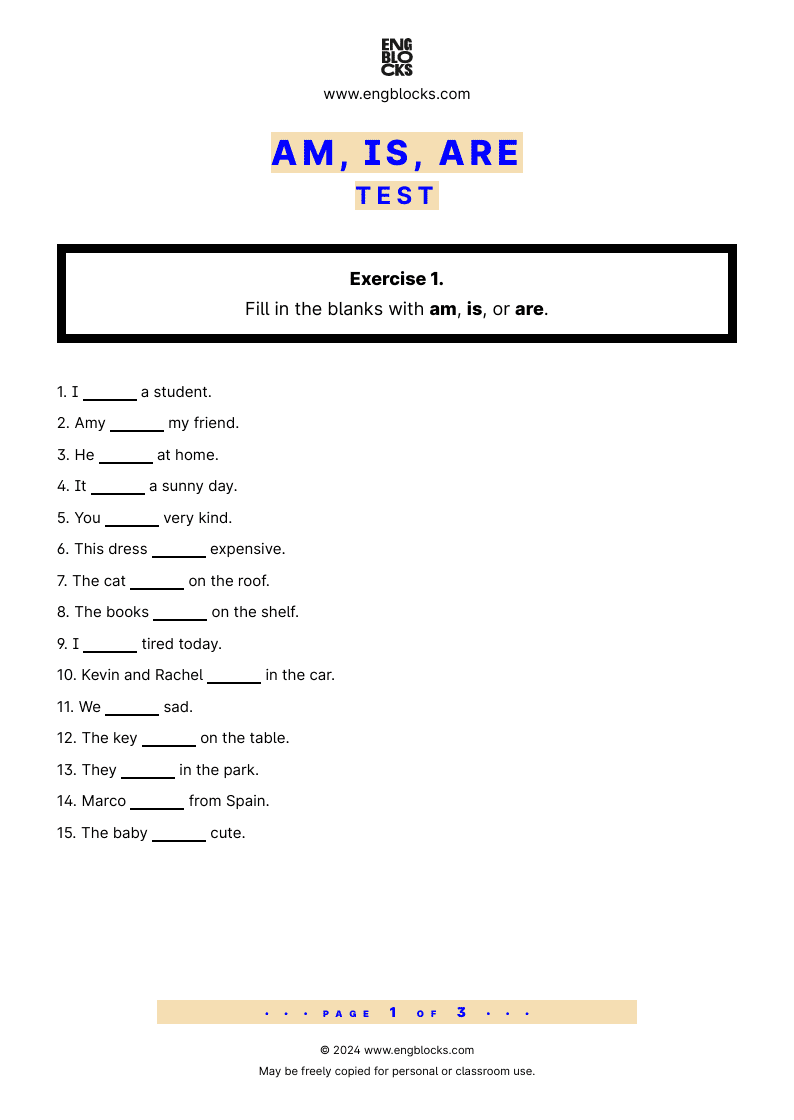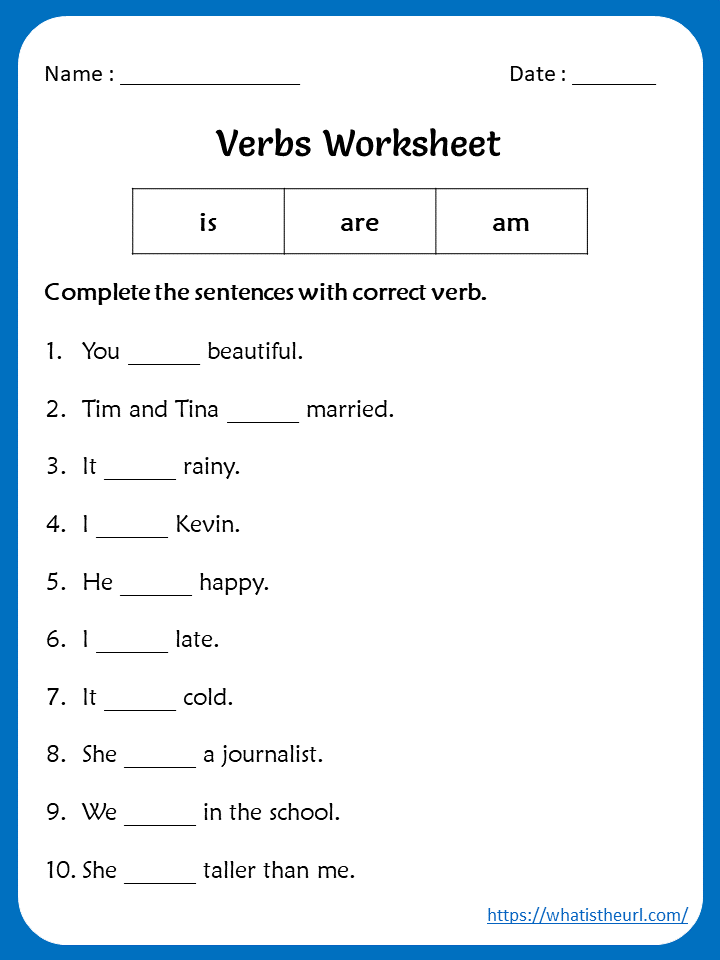
Mastering the Basics: The Indispensable Role of Grammar Worksheets: Am-Is-Are
In the vast and intricate landscape of the English language, certain foundational elements serve as cornerstones upon which all further learning is built. Among these, the verb "to be" in its present simple forms – "am," "is," and "are" – stands out as arguably the most fundamental. It is the very bedrock of expressing identity, state, location, and condition. For learners at all levels, from young native speakers to advanced ESL/EFL students, truly mastering these three simple words is not just a stepping stone, but a critical prerequisite for meaningful communication. And in this journey of mastery, Grammar Worksheets: Am-Is-Are emerge as indispensable tools, providing structured practice, immediate reinforcement, and a clear path to fluency.
This article delves deep into the significance of "am," "is," and "are," exploring why their correct usage is paramount, and how Grammar Worksheets: Am-Is-Are serve as the most effective pedagogical resource for cementing this essential knowledge. We will examine the various types of worksheets, their benefits, and strategies for both designing and utilizing them to achieve robust grammatical proficiency.
The Foundational Role of "Am," "Is," and "Are"

Before we extol the virtues of worksheets, it’s crucial to understand why "am," "is," and "are" hold such a pivotal position in English grammar. These are the three present simple forms of the irregular verb "to be," and they are used in a myriad of ways:

- To state identity: I am John. She is my sister. They are students.
- To describe characteristics or states: I am happy. He is tall. We are tired.
- To indicate location: She is at home. We are in the park. The books are on the table.
- To express age: I am 30 years old. He is five. They are teenagers.
- As part of the present continuous tense: I am reading. He is sleeping. They are playing.
- To form passive voice (present simple): The door is locked. The rules are explained.




Their omnipresence means that almost every simple sentence or question will, at some point, involve one of these forms. Errors in their usage are immediately noticeable and can lead to misunderstandings, hindering effective communication. For beginners, incorrectly saying "He are tall" or "They is here" is a common hurdle that needs to be overcome swiftly and thoroughly. This is where targeted, repetitive practice, often found in well-designed Grammar Worksheets: Am-Is-Are, becomes invaluable.
The Unmatched Power of Grammar Worksheets

In an age of interactive apps and online learning platforms, the humble worksheet might seem antiquated. However, its enduring efficacy, especially for foundational grammar points like "am," "is," and "are," cannot be overstated. Worksheets offer a unique blend of structure, repetition, and immediate feedback that is hard to replicate with other methods alone.
Here’s why Grammar Worksheets: Am-Is-Are are so powerful:

- Reinforcement and Repetition: Grammar learning is akin to building muscle memory. The more a learner practices a concept, the more ingrained it becomes. Worksheets provide precisely this opportunity for repeated exposure and application in varied contexts.
- Structured Practice: They break down complex concepts into manageable, bite-sized tasks. This systematic approach allows learners to build confidence gradually, moving from simple recognition to more complex production.
- Immediate Feedback (with Answer Keys): A well-designed worksheet often comes with an answer key, allowing learners to check their work instantly. This self-correction mechanism is crucial for identifying mistakes, understanding why they occurred, and solidifying correct usage without external intervention.
- Independent Learning: Worksheets empower learners to study at their own pace, outside of a classroom setting. This is particularly beneficial for review, homework, or for those who need extra practice on specific challenging points.
- Identification of Weaknesses: By observing patterns of errors on a worksheet, both learners and instructors can pinpoint specific areas that require more attention. For instance, a learner might consistently confuse "is" and "are" with plural subjects, signaling a need for more focused practice on subject-verb agreement.
- Building Confidence: Successfully completing a series of exercises on a worksheet provides a tangible sense of accomplishment. This positive reinforcement encourages learners and motivates them to tackle more complex grammatical structures.
- Visual and Kinesthetic Learning: The act of writing down answers engages kinesthetic learners, while the visual layout of a worksheet can be helpful for visual learners. It’s a multi-sensory approach to learning grammar.

Designing Effective Grammar Worksheets: Am-Is-Are
The effectiveness of a worksheet lies in its design. A good worksheet isn’t just a random collection of sentences; it’s a carefully crafted sequence of exercises that progressively challenges the learner. When creating or selecting Grammar Worksheets: Am-Is-Are, consider incorporating a variety of exercise types:
-
Simple Fill-in-the-Blanks:
- Concept: The most straightforward exercise. Learners fill in the blank with "am," "is," or "are."
- Example:
- I ____ a student.
- She ____ happy.
- They ____ friends.
- Benefit: Ideal for initial recognition and basic application, focusing purely on subject-verb agreement.
-
Matching Exercises:
- Concept: Match subjects (pronouns, nouns) with the correct form of "to be."
- Example:
- Match:
- I a. is
- He b. are
- We c. am
- Match:
- Benefit: Reinforces subject-verb agreement in a less demanding format, good for quick review.
-
Multiple Choice Questions:
- Concept: Learners choose the correct "am," "is," or "are" from a given set of options.
- Example:
- The cat (am / is / are) sleeping.
- We (am / is / are) going to the park.
- Benefit: Helps learners distinguish between correct and incorrect forms and can be used to introduce common distractors.
-
Sentence Transformation/Rewriting:
- Concept: Learners rewrite sentences, changing the subject or making them negative/interrogative.
- Example:
- Rewrite using "not": He is tired. -> He is not tired.
- Change to a question: They are at home. -> Are they at home?
- Benefit: Moves beyond simple recognition to active manipulation of sentence structure, crucial for real-world communication.
-
Error Correction:
- Concept: Learners identify and correct mistakes in sentences where "am," "is," or "are" are used incorrectly.
- Example:
- She are my sister. (Correction: She is my sister.)
- We is going. (Correction: We are going.)
- Benefit: Develops critical thinking and reinforces correct usage by highlighting common errors.
-
Picture-Based Exercises:
- Concept: Learners describe pictures using "am," "is," or "are."
- Example: Show a picture of a girl reading. Prompt: She ____ reading a book. Show a picture of two boys playing. Prompt: They ____ playing soccer.
- Benefit: Connects grammar to real-world visuals, making it more engaging and memorable, especially for younger learners or visual learners.
-
Creating Original Sentences:
- Concept: Learners create their own sentences using given subjects and the correct form of "to be."
- Example:
- Use "I" and "am" to describe a feeling.
- Use "They" and "are" to describe a location.
- Benefit: Moves from controlled practice to free production, encouraging creative application and deeper understanding.
-
Dialogue Completion:
- Concept: Fill in "am," "is," or "are" in a short dialogue.
- Example:
- A: Where ____ you?
- B: I ____ in the kitchen.
- Benefit: Places grammar in a communicative context, preparing learners for natural conversation.
-
Short Paragraph Writing:
- Concept: Learners write a short paragraph about themselves, their family, or a scene, using "am," "is," and "are" frequently.
- Example: "Write 5 sentences about your best friend, using ‘is’ and ‘are’."
- Benefit: Integrates the target grammar point into extended writing, demonstrating comprehensive understanding and application.
When designing these Grammar Worksheets: Am-Is-Are, remember to:
- Provide clear instructions: Leave no room for ambiguity.
- Vary difficulty: Start simple and gradually increase complexity.
- Include an answer key: Essential for self-correction.
- Make them visually appealing: Use clear fonts, ample white space, and perhaps simple illustrations.
Implementing Worksheets in the Learning Journey
Worksheets are versatile and can be implemented in various learning scenarios:
- In the Classroom: Teachers can use them for warm-up activities, in-class practice, group work, or quick assessments. They are excellent for differentiating instruction, providing extra support for struggling students or additional challenges for advanced ones.
- For Homework: They offer a structured way for students to reinforce what they’ve learned in class and to identify areas where they might need more help.
- For Self-Study: Independent learners can use them to teach themselves, review concepts, and track their progress. The immediate feedback from answer keys makes this highly effective.
- For Parents: Parents can use worksheets to support their children’s English learning at home, providing a tangible activity to work on together.
Common Pitfalls and How Worksheets Address Them
Learners often stumble on specific aspects of "am," "is," and "are." Grammar Worksheets: Am-Is-Are are particularly effective in targeting these common pitfalls:
- Subject-Verb Agreement: The most frequent error is mismatching the subject with the verb form (e.g., "He are," "They is"). Worksheets with repeated fill-in-the-blanks and error correction exercises directly address this by forcing learners to pay attention to the subject.
- Confusion with Other Verbs: Beginners might incorrectly use "to be" where another verb is needed (e.g., "I am go to school"). Worksheets that require selecting between "am/is/are" and other simple verbs (like "go," "have," "do") can help clarify this.
- Negative and Question Forms: Forming negatives ("I am not," "He is not") and questions ("Am I?", "Is he?") correctly can be tricky. Dedicated transformation exercises on worksheets provide the necessary practice for these specific structures.
- Contractions: Understanding and using contractions like "I’m," "He’s," "They’re" is crucial for natural speech. Worksheets can include exercises specifically on expanding contractions or forming them.
By providing focused, repetitive practice, these worksheets help learners internalize the correct patterns, making the right usage almost automatic over time.
Beyond the Worksheet: Integrating Learning
While Grammar Worksheets: Am-Is-Are are incredibly effective for foundational practice, it’s vital to remember they are a tool, not the entire learning process. The ultimate goal is for learners to use "am," "is," and "are" naturally and correctly in real-world communication. Therefore, worksheet practice should always be complemented by:
- Speaking Activities: Role-playing, interviews, describing pictures aloud.
- Listening Practice: Identifying "am," "is," "are" in dialogues, songs, or videos.
- Reading: Observing how these verbs are used in stories, articles, and everyday texts.
- Creative Writing: Encouraging learners to write short stories, journal entries, or descriptions where they actively apply the learned forms.
The worksheets build the foundational accuracy, and these communicative activities provide the fluency and confidence to use that accuracy in dynamic contexts.
The Future of Grammar Worksheets: Am-Is-Are
As technology advances, so too does the potential for enhancing the traditional worksheet. Digital Grammar Worksheets: Am-Is-Are offer interactive elements, instant automated feedback, gamification, and adaptive learning paths. Online platforms can track learner progress, identify persistent errors, and even generate personalized exercises. While the paper-based worksheet will always have its place, the future promises even more dynamic and engaging ways to practice these essential grammar points.
Conclusion
The journey to English proficiency begins with a solid understanding of its most basic components. "Am," "is," and "are" are not just simple words; they are the connective tissue of countless sentences, essential for expressing identity, state, and location. For educators, learners, and parents alike, Grammar Worksheets: Am-Is-Are stand as an unparalleled resource in cementing this fundamental knowledge.
Through their structured practice, repetitive reinforcement, and immediate feedback mechanisms, these worksheets provide the critical scaffolding needed for learners to build confidence, identify and correct errors, and ultimately achieve mastery. While they are a means to an end, the efficacy of Grammar Worksheets: Am-Is-Are in laying a strong grammatical foundation remains undeniable, paving the way for more complex linguistic endeavors and truly effective communication.
